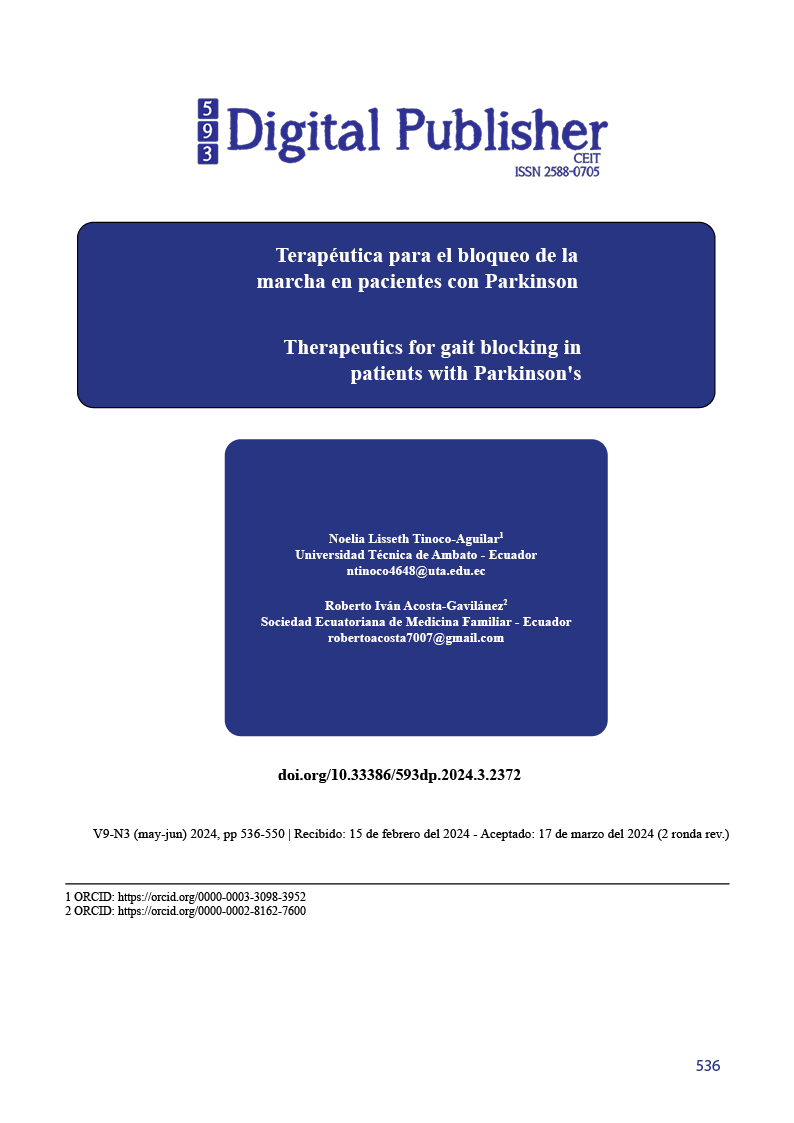Terapéutica para el bloqueo de la marcha en pacientes con Parkinson
Contenido principal del artículo
Resumen
La enfermedad de Parkinson es un trastorno neurológico crónico y progresivo que afecta principalmente el sistema motor, incluida la marcha. La alteración de la marcha es uno de los síntomas más incapacitantes y debilitantes para los pacientes con Parkinson. Como objetivo se pretende definir las intervenciones de la enfermedad de Parkinson abordando los enfoques tradicionales y no tradicionales para mejorar la marcha en pacientes con enfermedad de Parkinson y proporcionar recomendaciones para la práctica clínica. Se realizo una revisión narrativa de la literatura y una revisión sistemática de ensayos controlados aleatorios (ECA). Estas revisiones resumieron las intervenciones de la enfermedad de Parkinson abordando los enfoques tradicionales y no tradicionales para mejorar la marcha en pacientes con EP en los últimos 10 años, todas las búsquedas se realizaron en PubMed y Scopus y la selección del estudio fue realizada de forma independiente. Como resultados principales se obtiene que el bloqueo de la marcha es un síntoma debilitante y común en pacientes con enfermedad de Parkinson (EP), que limita significativamente su movilidad y calidad de vida. Se establecen enfoques farmacológicos, como la levodopa, y la yuxtaposición de la deferiprona que pueden mejorar temporalmente la marcha en algunos pacientes y se evidencio terapias físicas, como la fisioterapia y la estimulación cerebral profunda. Se concluye que se puede utilizar terapias neuroquirúrgicas, farmacológicas o no farmacológicas se basa en una evaluación exhaustiva de la historia clínica del paciente, la gravedad de los síntomas y los riesgos y beneficios potenciales de la intervención.
Descargas
Detalles del artículo

Esta obra está bajo una licencia internacional Creative Commons Atribución-NoComercial-CompartirIgual 4.0.
1. Derechos de autor
Las obras que se publican en 593 Digital Publisher CEIT están sujetas a los siguientes términos:
1.1. 593 Digital Publisher CEIT, conserva los derechos patrimoniales (copyright) de las obras publicadas, favorece y permite la reutilización de las mismas bajo la licencia Licencia Creative Commons 4.0 de Reconocimiento-NoComercial-CompartirIgual 4.0, por lo cual se pueden copiar, usar, difundir, transmitir y exponer públicamente, siempre que:
1.1.a. Se cite la autoría y fuente original de su publicación (revista, editorial, URL).
1.1.b. No se usen para fines comerciales u onerosos.
1.1.c. Se mencione la existencia y especificaciones de esta licencia de uso.
Citas
Allen, N. E., Canning, C. G., Almeida, L. R. S., Bloem, B. R., Keus, S. H. J., Löfgren, N., Nieuwboer, A., Verheyden, G. S. A. F., Yamato, T. P., & Sherrington, C. (2022). Interventions for preventing falls in Parkinson’s disease. Cochrane Database of Systematic Reviews, 2022(6). https://doi.org/10.1002/14651858.CD011574.pub2
Bloem, B. R., Okun, M. S., & Klein, C. (2021). Parkinson’s disease. The Lancet, 397(10291), 2284–2303. https://doi.org/10.1016/S0140-6736(21)00218-X
Church, F. C. (2021). Review treatment options for motor and non‐motor symptoms of parkinson’s disease. Biomolecules, 11(4). https://doi.org/10.3390/biom11040612
Cucca, A., Di Rocco, A., Acosta, I., Beheshti, M., Berberian, M., Bertisch, H. C., Droby, A., Ettinger, T., Hudson, T. E., Inglese, M., Jung, Y. J., Mania, D. F., Quartarone, A., Rizzo, J. R., Sharma, K., Feigin, A., Biagioni, M. C., & Ghilardi, M. F. (2021). Art therapy for Parkinson’s disease. Parkinsonism and Related Disorders, 84, 148–154. https://doi.org/10.1016/j.parkreldis.2021.01.013
Degirmenci, Y., Angelopoulou, E., Epameinondas, V., & Bougea, A. (2023). Deterioro cognitivo en la enfermedad de Parkinson: Descripción general centrándose en productos farmacéuticos emergentes. MEDICINA, 59. https://doi.org/10.3390/medicina59101756
Degirmenci, Y., Angelopoulou, E., Georgakopoulou, V. E., & Bougea, A. (2023). Cognitive Impairment in Parkinson’s Disease: An Updated Overview Focusing on Emerging Pharmaceutical Treatment Approaches. Medicina (Lithuania), 59(10), 1–17. https://doi.org/10.3390/medicina59101756
Deuschl, G., Antonini, A., Costa, J., Śmiłowska, K., Berg, D., Corvol, J. C., Fabbrini, G., Ferreira, J., Foltynie, T., Mir, P., Schrag, A., Seppi, K., Taba, P., Ruzicka, E., Selikhova, M., Henschke, N., Villanueva, G., & Moro, E. (2022). European Academy of Neurology/Movement Disorder Society - European Section guideline on the treatment of Parkinson’s disease: I. Invasive therapies. European Journal of Neurology, 29(9), 2580–2595. https://doi.org/10.1111/ene.15386
Espinoza-Vinces, C., Villino-Rodríguez, R., Atorrasagasti-Villar, A., Martí-Andrés, G., & Luquin, M.-R. (2023). Impact of Safinamide on Patient-Reported Outcomes in Parkinson’s Disease. Patient Related Outcome Measures, 14, 285–295. https://doi.org/10.2147/prom.s369590
Gaßner, H., Trutt, E., Seifferth, S., Friedrich, J., Zucker, D., Salhani, Z., Adler, W., Winkler, J., & Jost, W. H. (2022). Treadmill training and physiotherapy similarly improve dual task gait performance: a randomized-controlled trial in Parkinson’s disease. Journal of Neural Transmission, 129(9), 1189–1200. https://doi.org/10.1007/s00702-022-02514-4
Hariz, M., & Blomstedt, P. (2022a). Deep brain stimulation for Parkinson’s disease. Journal of Internal Medicine, 292(5), 764–778. https://doi.org/10.1111/joim.13541
Hariz, M., & Blomstedt, P. (2022b). Deep brain stimulation for Parkinson’s disease. Journal of Internal Medicine, 292(5), 764–778. https://doi.org/10.1111/joim.13541
Horsager, J., Andersen, K. B., Knudsen, K., Skjærbæk, C., Fedorova, T. D., Okkels, N., Schaeffer, E., Bonkat, S. K., Geday, J., Otto, M., Sommerauer, M., Danielsen, E. H., Bech, E., Kraft, J., Munk, O. L., Hansen, S. D., Pavese, N., Göder, R., Brooks, D. J., … Borghammer, P. (2020). Brain-first versus body-first Parkinson’s disease. Brain, 143(10), 3077–3088. https://doi.org/10.1093/brain/awaa238
Horsager, J., Andersen, K., Knudsen, K., Skjærbæk, C., Fedorova, T., Okkels, N., Schaeffer, E., Bonkat, S., & Otto, M. (2020). Body-first versus brain-first biological subtyping of Parkinson’s disease. Brain, 143(10), 2871–2873. https://doi.org/10.1093/brain/awaa293
Hulzinga, F., Seuthe, J., D’Cruz, N., Ginis, P., Nieuwboer, A., & Schlenstedt, C. (2023). Split-Belt Treadmill Training to Improve Gait Adaptation in Parkinson’s Disease. Movement Disorders, 38(1), 92–103. https://doi.org/10.1002/mds.29238
Johansson, M. E., Cameron, I. G. M., Van der Kolk, N. M., de Vries, N. M., Klimars, E., Toni, I., Bloem, B. R., & Helmich, R. C. (2022). Aerobic Exercise Alters Brain Function and Structure in Parkinson’s Disease: A Randomized Controlled Trial. Annals of Neurology, 91(2), 203–216. https://doi.org/10.1002/ana.26291
Krauss, J. K., Lipsman, N., Aziz, T., Boutet, A., Brown, P., Chang, J. W., Davidson, B., Grill, W. M., Hariz, M. I., Horn, A., Schulder, M., Mammis, A., Tass, P. A., Volkmann, J., & Lozano, A. M. (2021). Technology of deep brain stimulation: current status and future directions. Nature Reviews Neurology, 17(2), 75–87. https://doi.org/10.1038/s41582-020-00426-z
Li, G., Huang, P., Cui, S. S., Tan, Y. Y., He, Y. C., Shen, X., Jiang, Q. Y., Huang, P., He, G. Y., Li, B. Y., Li, Y. X., Xu, J., Wang, Z., & Chen, S. Di. (2022). Mechanisms of motor symptom improvement by long-term Tai Chi training in Parkinson’s disease patients. Translational Neurodegeneration, 11(1), 1–10. https://doi.org/10.1186/s40035-022-00280-7
Mahoney-Sánchez, L., Bouchaoui, H., Ayton, S., Devos, D., Duce, J. A., & Devedjian, J. C. (2021). Ferroptosis and its potential role in the physiopathology of Parkinson’s Disease. Progress in Neurobiology, 196, 1–52. https://doi.org/10.1016/j.pneurobio.2020.101890
Prange, S., Klinger, H., Laurencin, C., Danaila, T., & Thobois, S. (2022). Depression in Patients with Parkinson’s Disease: Current Understanding of its Neurobiology and Implications for Treatment. Drugs and Aging, 39(6), 417–439. https://doi.org/10.1007/s40266-022-00942-1
Sarasso, E., Agosta, F., Piramide, N., Gardoni, A., Canu, E., Leocadi, M., Castelnovo, V., Basaia, S., Tettamanti, A., Volontè, M. A., & Filippi, M. (2021). Action Observation and Motor Imagery Improve Dual Task in Parkinson’s Disease: A Clinical/fMRI Study. Movement Disorders, 36(11), 2569–2582. https://doi.org/10.1002/mds.28717
Sun, C., & Armstrong, M. J. (2021). Treatment of parkinson’s disease with cognitive impairment: Current approaches and future directions. Behavioral Sciences, 11(4). https://doi.org/10.3390/bs11040054
Tan, Y. Y., Jenner, P., & Chen, S. Di. (2022). Monoamine Oxidase-B Inhibitors for the Treatment of Parkinson’s Disease: Past, Present, and Future. Journal of Parkinson’s Disease, 12(2), 477–493. https://doi.org/10.3233/JPD-212976
Van Den Berge, N., & Ulusoy, A. (2022). Animal models of brain-first and body-first Parkinson’s disease. Neurobiology of Disease, 163, 105599. https://doi.org/10.1016/j.nbd.2021.105599
Vijiaratnam, N., Simuni, T., Bandmann, O., Morris, H. R., & Foltynie, T. (2021). Progress towards therapies for disease modification in Parkinson’s disease. The Lancet Neurology, 20(7), 559–572. https://doi.org/10.1016/S1474-4422(21)00061-2
Yan, J., Smith, R., & Lee, L. (2022). Congelación marcha en la enfermedad sistemática y un metanálisis en red. Revista de Neurología, 269, 3325–3327. https://doi.org/10.1007/s00415-022-11076-0



